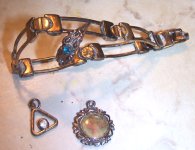Steve in PR
Junior Member
One of the disadvantages I have here is the highly corrosive/conductive nature of salt water. Today was a lesson in what happens when 2 different metals come into contact in the sand and salt water for a long time. It isn't just the water and the dissimilar metals. The mud also has chemicals like sulfur and other minerals and biological by-products which add to the mix. The Bracelet tests 14 Kt and weighs a hefty 13.7 grams. What you see in the picture is what I had after carefully separating the bottle cap from the bracelet. It had "melded" to the bracelet and formed a calcium bond. Real hard material. The gray material is what it looked like before I cleaned it. It really makes a mess! I bought anm ultrasonic cleaner and the results, so far, look promising.
The small, copper toe-ring dangling from the bracelet was found while I was looking for a young lady's belly button piercing thingy. It was real small and I am sure it will never be found by me because it was smaller than the holes in my scoop! Oh well, she will just have to go get punctured again...
The triangle object is possibly gold and the medallion is silver.
There was an extraordinary amount of bikinis on the beach today. That and great weather made it a glorious hunting day!
That and great weather made it a glorious hunting day!
The small, copper toe-ring dangling from the bracelet was found while I was looking for a young lady's belly button piercing thingy. It was real small and I am sure it will never be found by me because it was smaller than the holes in my scoop! Oh well, she will just have to go get punctured again...
The triangle object is possibly gold and the medallion is silver.
There was an extraordinary amount of bikinis on the beach today.
 That and great weather made it a glorious hunting day!
That and great weather made it a glorious hunting day!


